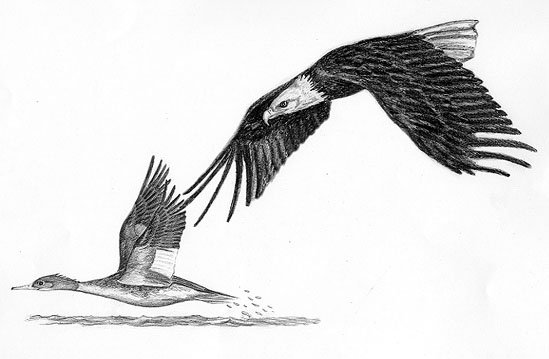
Dear Bird Folks,
I often observe the birds in my yard flying across the pond. It appears they would do very well in a 1/4 mile drag race. How fast do birds fly?
-Paul, Brewster
Oh Great Paul,
You had to mention “drag racing”. I knew it was only a matter of time before that surging NASCAR lingo worked its way into New England. Soon customers will be asking for bird feeders with STP or Goodyear stickers on them. They’ll want to know if we sell binoculars with a “HEMI” and instead of the Everglades birders will being taking birding trips to Daytona. It’s only a matter of time.
Flying is what makes a bird a bird. (That last sentence is pretty profound so you may want to write it down.) Mammals, the self-proclaimed premiere creature on the planet, have yet to master the art of flying (except for the lowly bat), unless they are willing to purchase a ticket two weeks in advance and wait in long lines. Flying is the mode that most birds use to escape danger, search for food, attract a mate and to transport themselves from one backyard to the next or from one continent to another.
Birds come in all shapes, sizes and flying abilities. Some birds like quail are only adequate flyers. They are more comfortable on the ground and only fly in short bursts, when they are forced to. Hummingbirds, on the other hand, are astounding flyers. They can hover, fly backwards or vanish instantly at the first sign of danger. With their lightening quick speed you would swear that hummers are the fastest of all birds. However, a hummingbird’s speed is only an illusion because of its size. They aren’t even fast enough to keep up with those fat old Canada Geese.
Besides their physical abilities, there are other factors that influence a bird’s flight speed. Winds are a major factors. A flock of Lapwings made the 2,200 mile trip across the Atlantic, from Britain to Newfoundland, in a twenty-four hour period. That’s an average of ninety miles per hour! How was it possible for a flock of birds to fly at 90 MPH, for twenty-four hours straight, and not get a ticket? They had the aide of a tail wind. A tail wind pushes a bird much faster than it would ever be able flap on its own.
Most birds have several levels of speed. They fly the fastest when they are pursuing prey or when they are being pursued as prey. Then there is the steady but urgent migration flight. A less hurried flight is used for short distances, like the birds flying across your pond. Finally there is mega-slow-speed that is found in birds that fly so slowly that all the other birds are backed-up behind them. These birds usually only fly on Sunday and have Florida license plates.
With all of those factors in mind it’s pretty tough to accurately answer how fast birds fly. A good rule of thumb for most feeder birds is 20 MPH, but that can increase dramatically if there is trouble or if they need to catch a cab.
Remember, we are only talking feeder birds here. Other species of birds have been known to reach some ridiculous speeds. Years ago Mass Audubon’s Bob Prescott told me a story of seeing a Red-breasted Merganser that was trapped in a small pool of water by a Bald Eagle. Every time the eagle attacked, the merganser would escape by diving underwater. Slowly tiring from the attacks, the merganser decided to make a run for it and took off from protection of the pool. The birders gasped, feeling the duck had made fatal mistake, only to be shocked as the merganser blew past the eagle like it was stump. It turns out the Red-breasted Mergansers are one of the fastest flying ducks. One report claimed a merganser’s escape speed can reach 80 MPH. Evidently, the hungry eagle never read that report and it had to settle for Chinese take-out that night.
The disputed title of the world’s fastest bird is most often given to the Peregrine Falcon. The peregrine can reach speeds of over 200 MPH. The title is disputed because the falcon only can reach those extreme speeds in a steep dive and not in level flight. Critics argue that the bird shouldn’t be given credit since gravity is doing most of the work. Claims have also been made that in addition to gravity, the falcon gains extra power by using a HEMI, but you only hear that declaration from the NASCAR crowd.